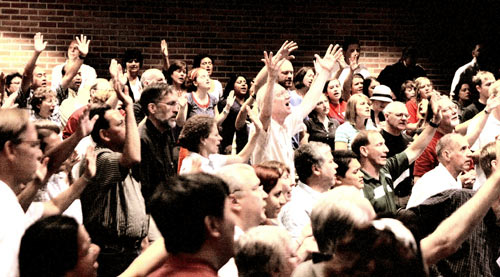|
The Beginnings of the
Life in the Spirit Seminars
by
Steve Clark
The Life in the Spirit Seminars (LSS) began
to develop about 7 months after the beginning
of the charismatic renewal. Like most of the
early leaders of the Charismatic Renewal, we
had worked in the Cursillo movement. We were
now working at the Catholic student center at
the University of Michigan and began a
charismatic prayer meeting [Ann Arbor,
Michigan USA].
In the middle of one of the first meetings,
someone asked to be baptized in the Spirit, so
we prayed for her then and there. The next two
meetings something similar happened. So we
decided to establish a time when people could
ask questions and receive prayer in order not
to interrupt the prayer meeting itself. First
we set up a prayer room after the prayer
meeting where people could come to be baptized
in the Spirit. Then we added a preparation
room. Then we added an explanation session
before the prayer meeting. With each addition
a higher percentage of the people got baptized
in the Spirit.
We then packaged all this together and
extended the time of initiation to six weekly
sessions. In the course of those sessions we
gave a fuller understanding of the gift of the
Spirit and how to persevere after being
baptized in the Spirit. We now put the focus
on ongoing living of the life in the Spirit
and decided to use the name “The Life in the
Spirit Seminars”. We also formed a team of
people who would work on the LSS and who could
keep contact with the new people and bring
them into the prayer group, subsequently the
community.
This was where our Cursillo experience had
been most helpful. It helped us to see that a
powerful initiatory experience needed a
follow-up and that an orientation to the
follow-up needed to be built into the LSS. It
also helped us to see that the follow-up
needed to be an environment of committed
people, and in addition that the weekend (and
the follow-up) needed a trained team of
leaders who did personal contact work with
those in the LSS – both during and after the
seminars. This was only one of the ways the
wisdom of the Cursillo movement on how to put
together an effective movement served the
Charismatic Renewal.
We then realized that we needed to add more of
an evangelistic focus. We needed to preach the
gospel in the seminars and make the message
more personally pointed. We made use of the
Four Spiritual Laws in the explanation
session, and we used the second session to
preach the gospel message. In a new fourth
session we presented the scriptural steps of
response to the gospel: repent, believe and be
baptized. That meant we included repentance
and obedience to God more prominently in the
seminars and made an effort to get the new
people to ascertain what they needed to repent
for.
The result was the 1971 and subsequent
editions of the LSS. Other versions have been
developed, but the original is still available
from Tabor
House in a Catholic and an ecumenical
edition and is very effective when done
correctly. It is, of course, not everything
people need for Christian maturity.
[This article © 2017
by Stephen B. Clark.originally
appeared in PENTECOST
Today Magazine, Volume 42 Number 1
Winter
2017. Used with permission.]
Steve Clark has been a
founding leader, author, and teacher for
the charismatic renewal since its
inception in 1976. He has authored a
number of books, including Baptized
in the Spirit and Spiritual Gifts,
Finding New Life in the Spirit,
Growing in Faith, and Knowing
God’s Will, Building Christian
Communities, Man and Woman in Christ.
Steve is past president of the Sword
of the Spirit, an
international ecumenical association of
charismatic covenant communities
worldwide. He is the founder of the Servants
of the Word, an ecumenical
international missionary brotherhood of
men living single for the Lord.
|

